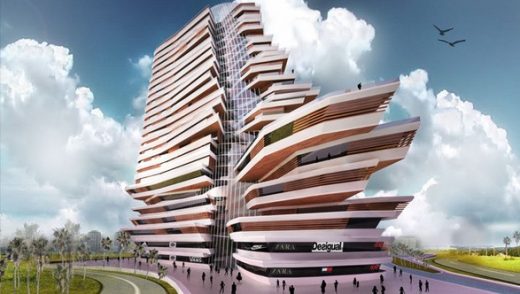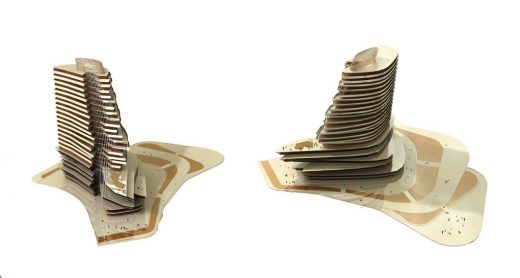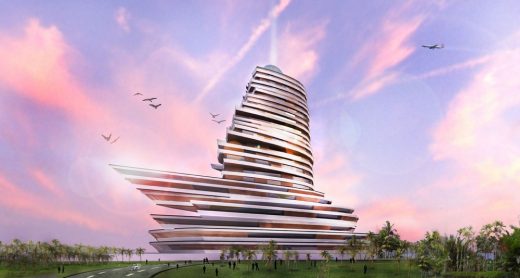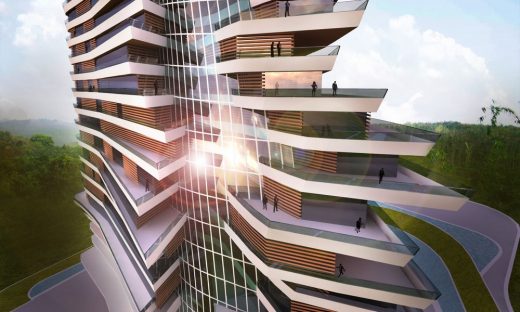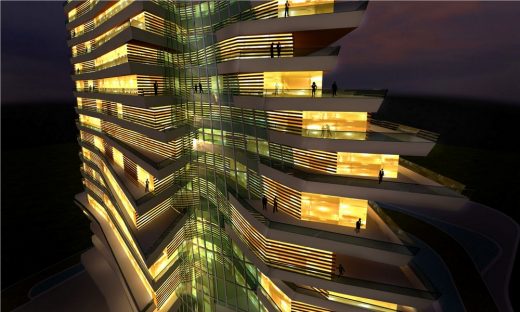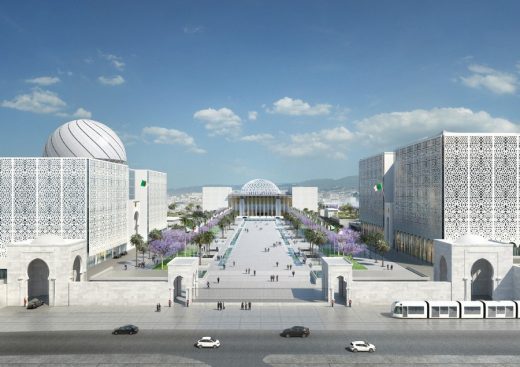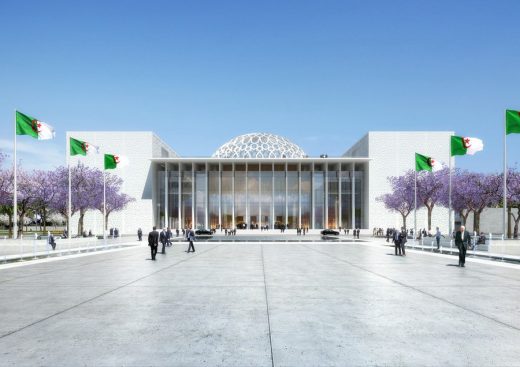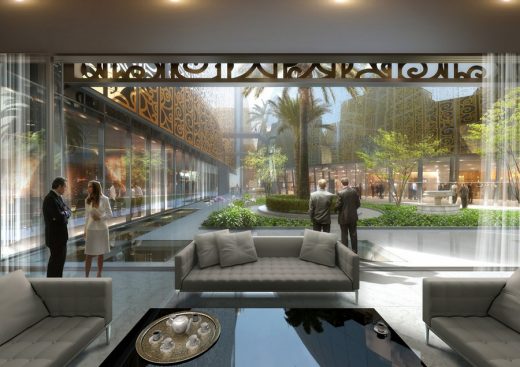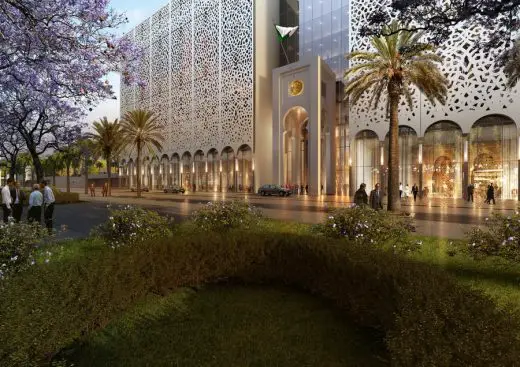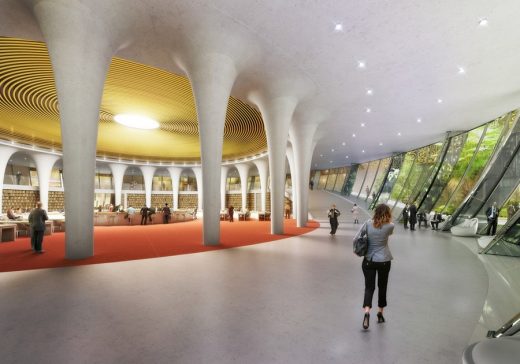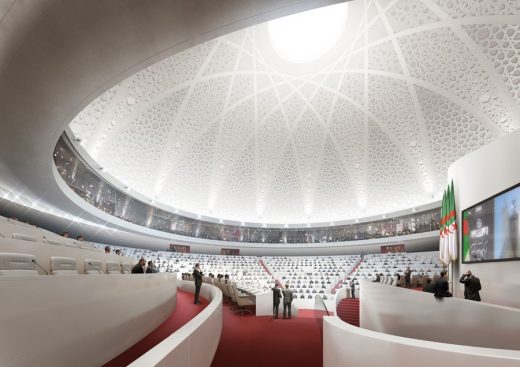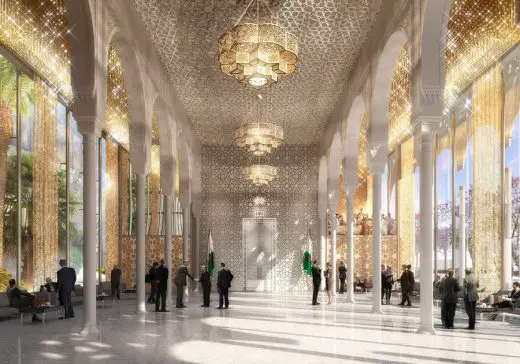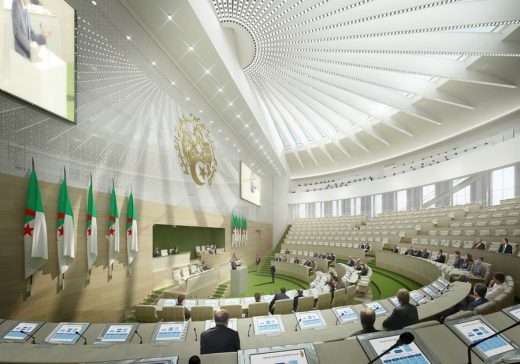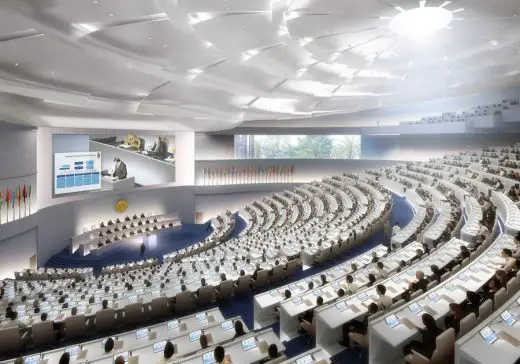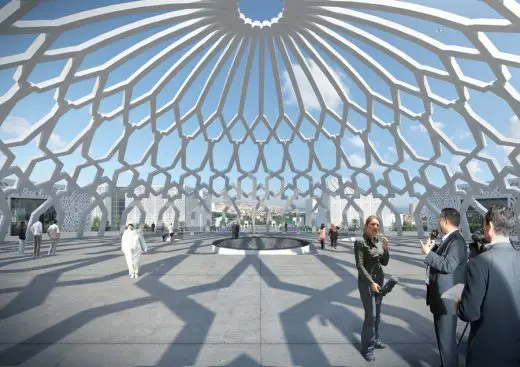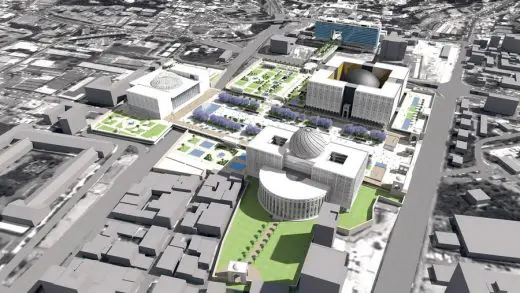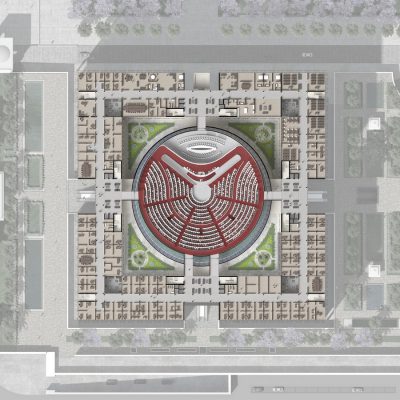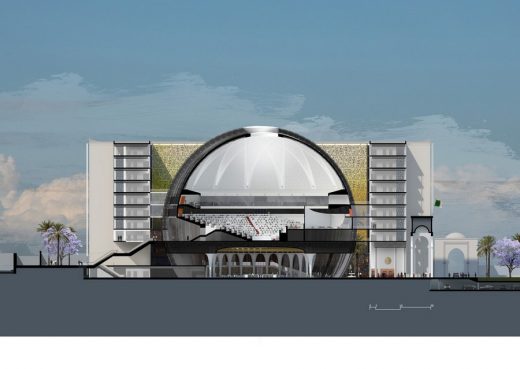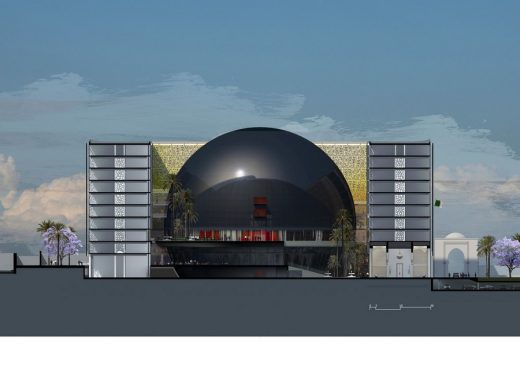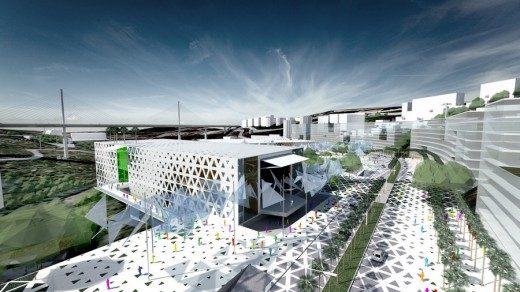Source: e-architect.com
Algeria is located on the Mediterranean, east of Morocco and west of Tunisia and Libya. e-architect try to select what we feel are the key examples of Algerian Architecture.
We aim to include Algerian buildings that are either of excellent quality.
We cover completed Algeria buildings and new building designs. We also post architecture competitions across Algeria. Our focus is on contemporary Algerian buildings.
Major Algerian Building Developments, alphabetical:
Grand Plaza Hotel in Cheraga
Design: DNA Barcelona Architects
image courtesy of architects office
The hotel has been designed in a manner that perfectly adapts to its environment. The design responds to the existing forms and the urban traces of its surroundings.
The goal of this project is to develop an iconic building, able to relate with the city, which provides new services and new sensations through architecture. This design could be compared with the shape of a ship, angular at its base, considerably higher on the levels above.
Furthermore, the creation of levels, different from each other, with large terraces overlooking the city, gives us the feeling that this large futuristic boat is in full motion by the wind.
With its avant-garde proposals resulting from the fusion of organic forms from nature, rigorous studies on the urban context, and the inclusion of social and cultural context within its own environment and design concepts, the design of each space is different and each is capable of creating different sensations to users. In that sense, the overlapping slabs, rotated between them and separated on the outside, which make up the skyscraper, are the terraces that seem to be in different plane, dancing in the wind in constant movement.
Geometrically speaking, all the lines are angular shapes, creating an imposing and impressive image, emphasizing still further the sense of fragility, as if at any time the slabs could fall from the heights by a strong gust of wind.
New Algerian Parliament: National Assembly
Design: Bureau Architecture Méditerranée
image courtesy of architects office
The New Algerian Parliament includes the People’s National Assembly, the National Council (Senate), the Chamber (Congress), and a residence for legislators.
Algeria’s new parliament is a project that must meet the highest standards.
The building needs to embody the idea of democracy in action, the Algeria of the future, freedom, peace, strong but deliberative power. The architecture must communicate a distinct national identity founded on universal values.
How can a 220,000 m2 complex convey openness, dialogue, debate – an essentially dialectical spirit – without defaulting to an architecture whose monumental scale creates a totalizing effect?
It is necessary to look to democracy’s architectural roots, which originate in the Mediterranean basin and span several millennia.
Those foundations start with a large public space, the plaza, a symbolic gathering place for the free people who give the republic its legitimacy and authority.
The new heart of Algeria’s parliamentary democracy is therefore to be located on a majestic square, with the largest dimensions possible for the site. The buildings will be significant not only in size, but first and foremost through the open public space that they define and designate.
Oriented on an east-west axis, with the historic city as a backdrop, the square unites East and West, the modernity of the new city and the tradition of the old.
A key element of the new political centre’s organization is the way in which it embodies significant ideas: the development of a democracy that successfully combines tradition and modernity, capable of serving the nation’s interests while remaining open to the world.
These notions underpin the architecture of the entire new political centre and the arrangement of the seats in the two legislative houses, the Senate and the Congress.
The location of the Parliamentary Assembly and the National Council on either side of the square creates a monumental gate serving as the entrance to the immense plaza. This arrangement, with the upper and lower houses facing each other on a north-south axis, completes the square’s organization around the cardinal points, along with its symbolism as a gathering place.
A conference hall shared by both houses, which will also be used for international meetings, forms the plaza’s eastern border. Located along the square’s main axis, the hall is at the centre of the new political complex’s layout.
The conference hall was given its prime position not only because joint sessions of the two legislative branches are crucial moments in democratic life, but also because the facility will host international delegations, and Algeria’s hospitality customs require that guests be given an honoured place.
Organized as they are, the centre’s major elements come together to create a space steeped in the symbolism of strong democratic values: freedom, assembly, a sense of history, tolerance and hospitality.
The buildings, being so closely related, are variations on common themes. The Senate and Congress buildings both have an assembly hall at the centre, surrounded by all the rooms needed for orderly operations, such as offices, meeting rooms, lobbies, etc.
This arrangement gives the outer rooms views of lush gardens and the Algiers skyline and harbour, while the assembly chambers add their domes to the skyline.
The domes, the intricate mouchrabiehs, the simplicity of the large volumes facing the vast square, and the luxuriant gardens are all in keeping with the long tradition of Arabic architecture, while the construction methods, glass façades, and climate and lighting control systems are all based on the most modern technology.
Viewed as a whole, the architecture thus situates itself clearly in historical, cultural and geographical context, while using technology in service to the sense of appropriateness and identity.
All of these elements come together in a tribute to the triumph of democracy: the buildings make a statement about the precious nature of this political system. The transition from exterior to interior is marked by a series of materials of progressively greater refinement and rarity.
The glass building façades are shielded by ceramic and concrete mouchrabiehs that diffuse sunlight and obscure views. The façades of the inner courtyards and assembly buildings are protected by gold leaf embedded in glass plates, and by leaves made of alabaster.
This sense of preciousness is also expressed through the use of water: in colourful mosaic-lined pools, gently babbling streams, and lively fountains that produce a cooling mist, as well as through the scent of orange and lemon trees, luxuriant vegetation and shade provided by fig trees.
By surrounding the complex with gardens – beyond the shadow of the assembly buildings overlooking the square – the site becomes a park echoing the famous parks of El Anasser or Diar el Mahcoul.
The construction of the new Algerian parliament and its grounds thus reveals all its facets: it is at once a tool of democracy and a tribute to it, an enlightening expression of the democratic order, a precious and yet familiar space, where all citizens will recognize the best of their culture and its values.
Bardo Cultural District in Algeria building
Design: Lemay | Altrapco
Location: Constantine, Algeria
The New Cultural Hub
In order to highlight the appointment of Constantine as the capital city of Arabic culture in 2015, the Wilaya Land Office launched an international competition for the design and construction of a new cultural hub in the Bardo District, in Constantine, Algeria.
The architectural proposal submitted by Lemay | Altrapco, which harmoniously combines culture and nature, has been selected as a finalist in this prestigious competition.
The proposal, which included a theater, a library, an art and history museum and an exhibition hall, intended to consolidate the natural environment of the valley of Bardo while revitalizing the old city to create a unique cultural destination.
This major project integrated exceptional accessibility while highlighting the site with a new park that would extend the existing forest to the centre of the city. Like an urban oasis, the new destination aims to attract visitors from all different walks of life while allowing citizens to take ownership of their exceptional natural and historical heritage.
Photographs: Lemay associés – Altrapco
Bardo Cultural District in Algeria images / information received 090914






